This entry includes a walking tour! Take the tour.
Introduction
Text-to-speech Audio
Carnifex Ferry Battlefield State Park preserves the history of a significant Civil War battle that occurred here while also offering recreational opportunities and breathtaking views of the rim of Gauley River Canyon. The battle of Carifex Ferry took place on September 10, 1861. In this battle, Union troops led by Brigadier General William S. Rosecrans engaged Confederate forces and forced them to evacuate their position on the Henry Patterson Farm that overlooked Carnifex Ferry. The Confederate commander, Brigadier General John B. Floyd, retreated across Carnifex Ferry to the south side of the Gauley River and then eastward to Meadow Bluff near Lewisburg. This Civil War battle represented the failure of a Confederate attempt to regain control of the Kanawha Valley. As a result, the movement for West Virginia statehood proceeded following the battle without a serious military threat from Confederate soldiers who remained in the area.
Images
Historic Marker
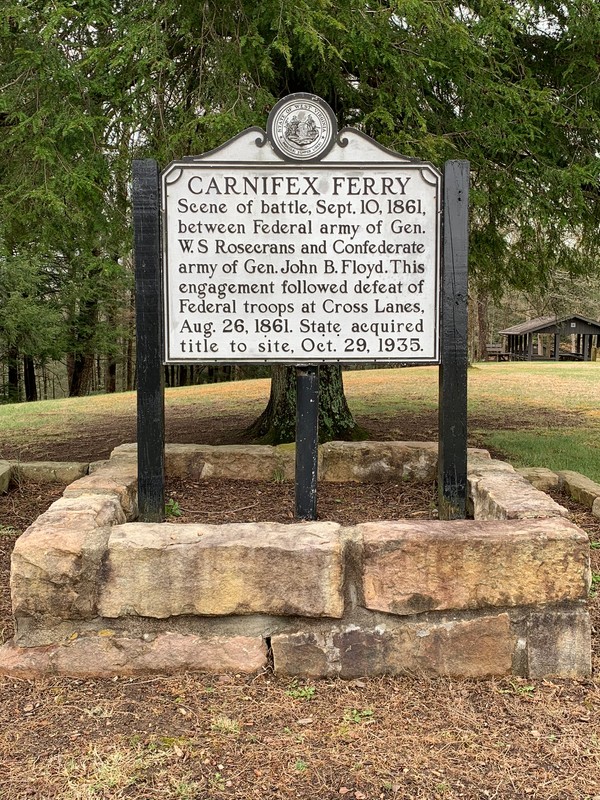
Trail Map of Carnifex Ferry Battlefield State Park
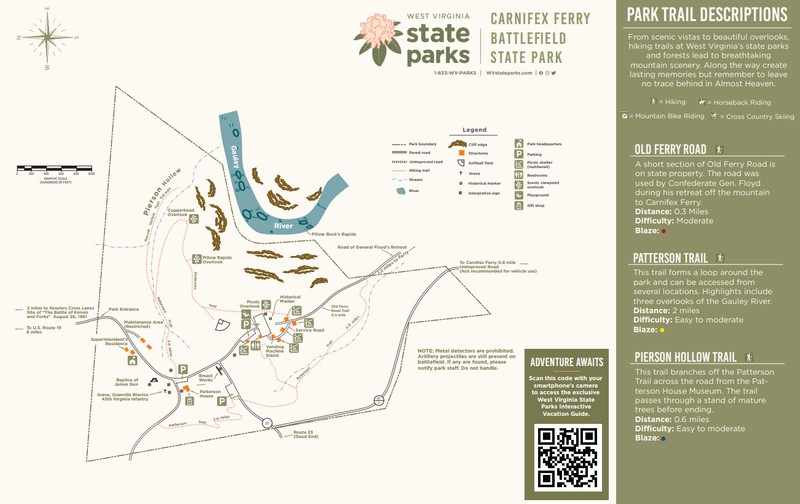
The Henry Patterson Home and Museum.
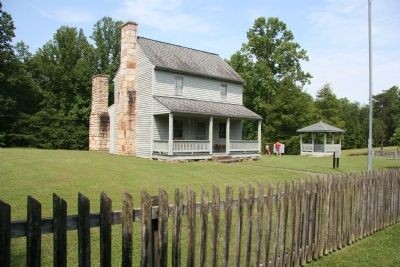
Historic Marker
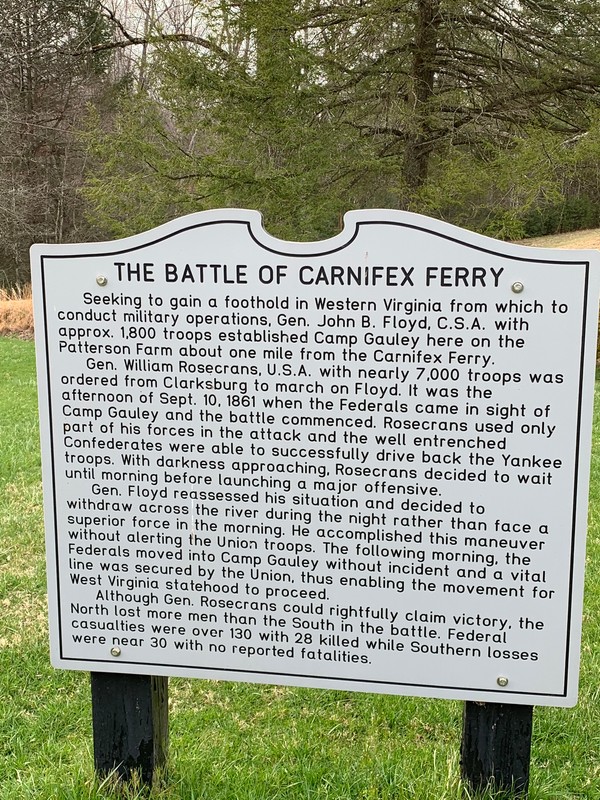
Map of the battle field of Carnifex Ferry, Gauley River, West Va., Sept. 10th 1861. United States forces commanded by Brig. Gen. W. S. Rosecrans
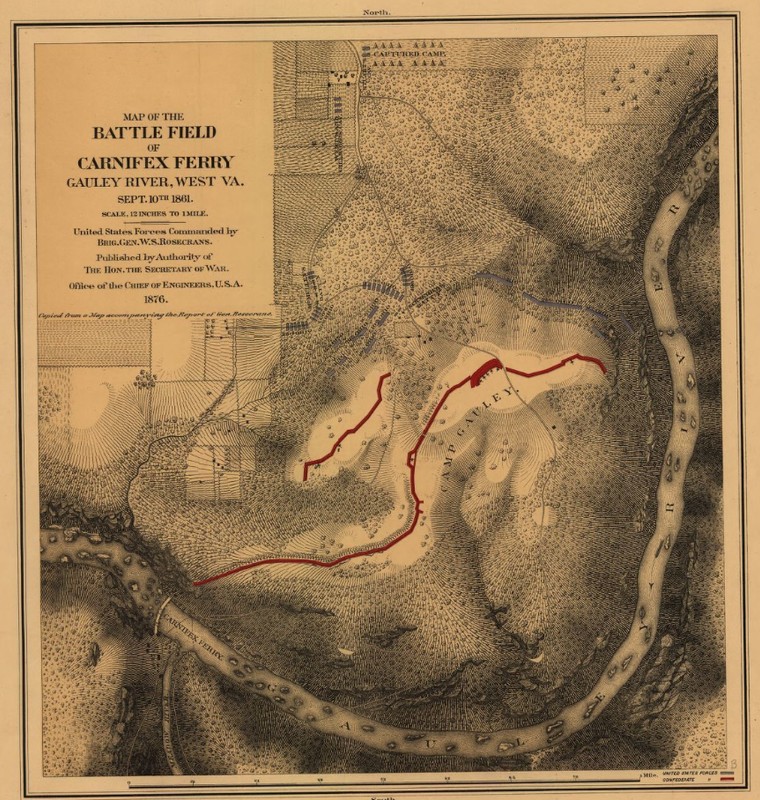
Battle of Carnifex Ferry (map by Heidi Perov for the WV Humanities Council)
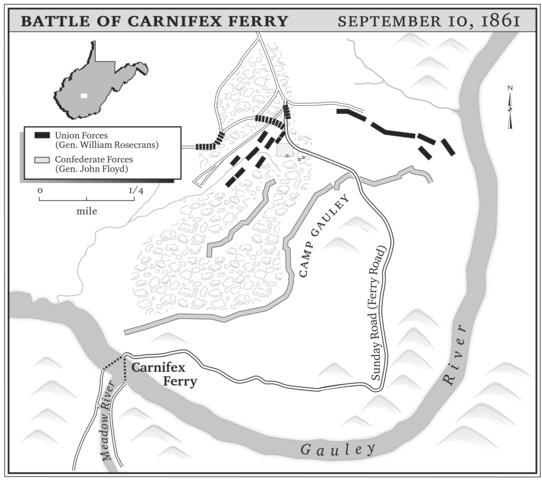
Union Brigadier General William S. Rosecrans
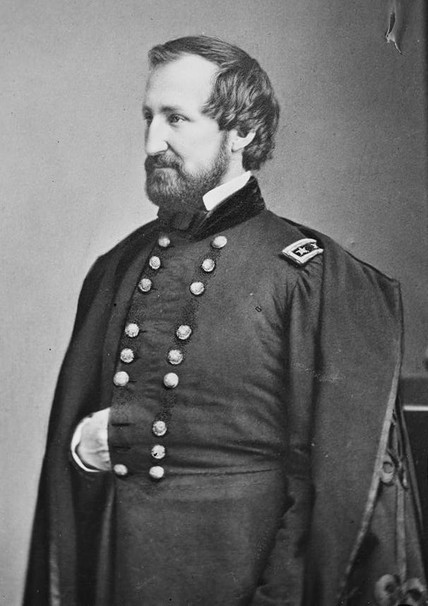
Confederate General John B. Floyd
.jpg)
Image of the Battle of Carnifex Ferry drawn in 1862 by J. Nep. Roesler of the 47th Ohio. (West Virginia History OnView)
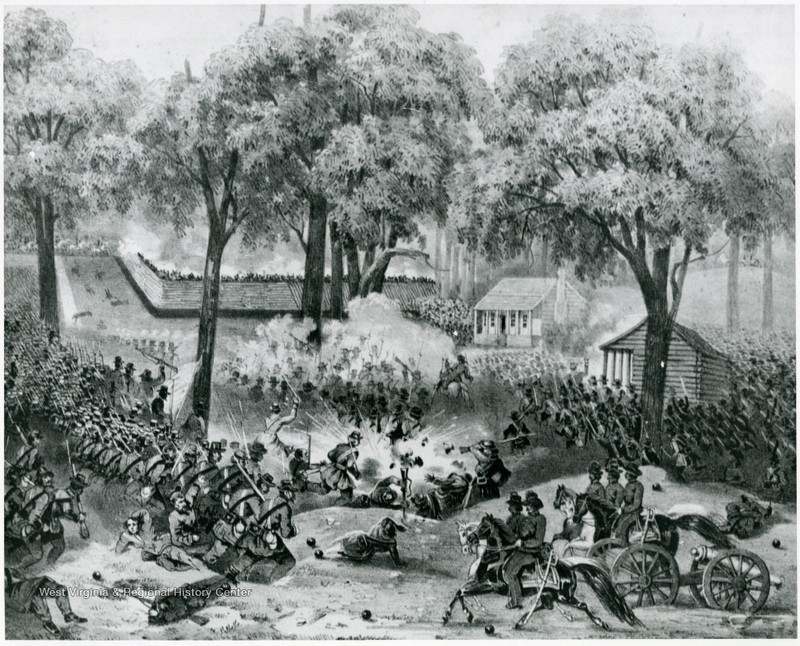
Carnifex Ferry Battlefield State Park.
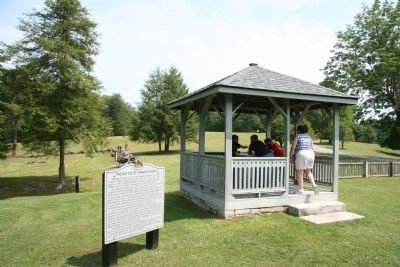
Historical Marker.
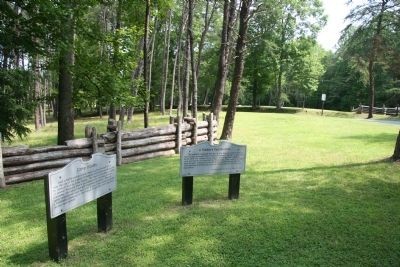
Backstory and Context
Text-to-speech Audio
Carnifex Ferry Battlefield is located in West Virginia near the Summersville Locks and Dam and overlooks the Gauley River Canyon. The battlefield is named for Carnifex Ferry, a small ferry at the confluence of the Meadow and Gauley Rivers. The state park houses the battlefield and also the Henry Patterson House that was caught in the crossfire during the battle; the house is preserved and you can still see the damage caused from the battle. The reenactment of the battle of Carnifex Ferry occurs on odd-numbered years. The Carnifex Ferry Battlefield State Park offers three overlooks of the Gauley River, picnic tables and shelters, hiking, and playground equipment.
Battle of Carnifex Ferry, September 10, 1861
After the first western Virginia campaign of May-June 1861 the Confederate forces had been driven out of the Tygart and Kanawha Valleys, claiming the western region for the Union. As the summer of 1861 progressed the Confederates wanted to retake the Kanawha Valley and then push north towards Wheeling to regain control of the region. Confederate Virginia was very concerned with maintaining control over the western portion of the state as Unionists were moving forward with establishing a loyal government. The Reorganized Government at Wheeling had already been recognized as the legitimate government of Virginia by the Lincoln administration and this government was working to secure new Unionist senators in Congress and raise Union regiments to fight in the war. By summer of 1861 the Confederates were facing the loss of western Virginia both militarily and politically.
Union General George McClellan had commanded the successful summer 1861 campaign, but he had been called to Washington after the Union defeat at First Manassas to reorganize the Army of the Potomac. Command of the operations in western Virginia passed to Brigadier General William S. Rosecrans. The Union had a defensive line that extended from Gauley Bridge to Cheat Mountain and then north to the Potomac to protect important transportation routes and secure the western portion of the state from Confederate control. For the Confederates, Major General Robert E. Lee was given his first field command and arrived in western Virginia on August 1st. When Lee assumed command there were several Confederate forces operating around the Kanawha Valley. The first was a Confederate force under Brigadier General W. W. Loring facing a Federal force under General Joseph J. Reynolds around Cheat Mountain. Further south in the Greenbrier region there were two Confederate forces under Brigadier General John B. Floyd and Brigadier General Henry A. Wise maneuvering around Union Brigadier General Jacob D. Cox’s force near Gauley Bridge.
The Gauley River was an important protective feature to the Union line, especially the line of communication linking Cox at Gauley Bridge to Rosecrans who was stationed at Clarksburg. The Gauley was largely uncrossable except for a few places due to steep cliffs and rapids. Carnifex Ferry was one of those crucial crossings over the Gauley. Located at the confluence of the Gauley and Meadow Rivers where there was a wider section of smooth water, Carnifex Ferry was a main connector from the Lewisburg Pike (the James River and Kanawha Turnpike) to the east into the Kanawha Valley. The ferry was a rope ferry just below the mouth of the Meadow River that operated in a triangular pattern with two flatboats that could carry one wagon at a time. On the western side of the ferry, the road intersections near Kessler’s Cross Lanes connected Gauley Bridge in the south to Summersville and the north and then Carnifex Ferry west to the Elk River. Cross Lanes was crucial to controlling the road network into the Kanawha Valley and western Virginia.
Floyd’s campaign plan was to use his and Wise’s forces to oppose Cox’s Union force at Gauley Bridge, push the Union troops out of the Kanawha Valley, move west towards Ohio, and then move up the Ohio River towards Wheeling to disrupt the meetings of the Unionist government. There was a referendum scheduled for October 24, 1861 concerning the western part of the state separating to become a new Unionist state and the Confederates wanted to regain control over western Virginia and disrupt that movement. By mid-August Cox was receiving intelligence that Confederate forces were maneuvering—this would have been the forces of Wise and Floyd gathering near White Sulphur Springs. Rosecrans had a small force stationed at Summersville to patrol and protect the road networks and on August 13th Rosecrans ordered the 7th Ohio to Cross Lanes to guard the intersection there. The regiment held their position for five days until Cox called them to move closer to Gauley Bridge on August 20th. With Floyd and Wise moving closer, Cox was worried they were planning an assault on Gauley Bridge, and he moved the 7th Ohio to Twenty Mile Creek to reinforce to his position.
The 7th Ohio soon returned to Cross Lanes, but in the time that they were gone Floyd crossed the Gauley with his troops. On August 21st, with intel that the Union force had left, he had his troops raise the ferry boats that the Union had previously scuttled and crossed his troops at Carnifex Ferry. Floyd began to entrench on the cliffs in the horseshoe bend of the Gauley. Wise did not join Floyd with his force. Floyd and Wise were both political appointees, both ex-governors of Virginia, and they did not like each other or work well together. Wise did not approve of the position that Floyd was taking up and he refused to cross the Gauley. Instead, Wise took his troops to Hawks Nest to threaten Cox at Gauley Bridge and prevent the Union force from moving on Floyd. Once Cox knew that Floyd had crossed at Carnifex Ferry he ordered the 7th Ohio to return to Cross Lanes and they returned to their positions at the intersection on August 25th. On the morning of August 26th, Floyd surprised the 7th Ohio at Cross Lanes and handily demolished the regiment. In doing so, the Confederates cut the communication lines between Cox and Rosecrans and took possession of the main transportation route into the Kanawha Valley.
After the disaster at Cross Lanes and with Floyd entrenching at Carnifex Ferry, Union General George McClellan (commanding the Army of the Potomac in eastern Virginia) became concerned that all the Union gains from earlier in the summer would be lost. He commanded Rosecrans to respond to the Floyd/Wise threat and on August 29th ordered Rosecrans to coordinate with Cox to trap Floyd and remove the Confederate threat. Rosecrans started to gather troops at Sutton on September 2nd and he arrived there on September 4th. By September 7th, Rosecrans had organized three provisional brigades as the Army of West Virginia and started the march south towards Carnifex Ferry. Rosecrans’ march continued September 8th and 9th, with a few small skirmishes with Confederate militia and rangers attempting to slow down their progress. Once Lee realized that the Union target was Carnifex Ferry he tried to warn Floyd, but Floyd was confident in his entrenched position. Floyd believed that Rosecrans would attack on the 12th or 13th and called for 1,600 reinforcements from Wise and other nearby units.
On the morning of September 10, 1861 Rosecrans’ column left Muddlety between 4:00 and 5:00am and moved towards Summersville. There was a slight halt when the Union army came upon a bridge burned by Confederate cavalry as a delaying tactic, but the Federals reached Summersville by 8:00am. Rosecrans did not have perfect intelligence as to Floyd’s position, although he tried to gain information from residents and captured Confederates on the march south. He believed that Floyd was still at Cross Lanes, where they had routed the 7th Ohio previously, and so the Union column approached the intersection cautiously with scouts and skirmishers sent out on either side of the road. Once they determined that Cross Lanes was clear, the Union column moved up to a position near the road that led to Carnifex Ferry. At this point Rosecrans still did not know the location of the Confederate line, and some of the Union men even thought that Floyd had completely retreated due to the large amount of equipment and supplies abandoned along the route. Rosecrans ordered his column to move forward down the road towards the ferry. Not having good information about the position or strength of the Confederate force, the Union First Brigade was ordered to only engage in reconnaissance.
[For a more detailed account of the Battle of Carnifex Ferry, explore the Patterson Trail battlefield tour] The Battle of Carnifex Ferry began around 3:00pm in the afternoon of September 10, 1861 when Floyd’s Confederate line fired on the Union First Brigade as they approached the Henry Patterson farm. The 10th Ohio took the brunt of the fighting in and around the Patterson cornfield for the first period of the battle. The majority of the fighting in this area was done by the 10th Ohio and 12th Ohio.
The main areas of fighting were around the Patterson House and on the Confederate right flank. Once the 10th Ohio became engaged with the center of the Confederate line ahead of the Patterson house, the 13th Ohio was sent to explore the ravine to the left, called Pierson Hollow. There the 13th Ohio discovered the Confederate right flank and successfully pushed the 45th Virginia back. Having discovered this weak point in the Confederate position, Rosecrans prepared a flank maneuver from Pierson Hollow to set off before dark, supported by another assault at the center and left of the Confederate position. Slow maneuvering in the heavy woods and darkness foiled this evening attack and Rosecrans decided to withdraw and renew the assault on the morning of September 11th.
Having held off the Union attack but knowing that Rosecrans would attack again on the morning of September 11th, Floyd decided to retreat across Carnifex Ferry during the night. Floyd successfully withdrew his troops and crossed the Gauley River, destroying the ferry behind them, without the Union army realizing. At daybreak on September 11th, the Union began its renewed attack but soon realized that the Confederates were gone. Unable to follow the retreating army over the destroyed ferry, Rosecrans remained at the battlefield sorting through the considerable amount of equipment and property left behind by Floyd’s force.
Floyd retreated east to Dogwood Gap where he was joined by General Wise who had been marching north to meet him at Carnifex Ferry and rerouted once he learned that Floyd had retreated. The two Confederate forces continued east where Wise positioned his men at Sewell Mountain and Floyd continued 16 miles further to Meadow Bluff.
Both Floyd and Rosecrans claimed victory at the Battle of Carnifex Ferry. Floyd was proud of his men for holding out a Union force that outnumbered them three to one. However, Rosecrans held the field at the end of the day and so officially held the victory for the battle. In defeating Floyd and forcing him out of Camp Gauley, Rosecrans restored the communication lines between Cox at Gauley Bridge and Rosecrans’ base to the north. The Union victory also prevented the Confederate strategy of pushing into the Kanawha Valley and advancing north towards Wheeling to disrupt the unionist statehood meetings.
While Floyd and Rosecrans were engaged at Carnifex Ferry, Confederate General Robert E. Lee was also maneuvering against Cheat Mountain to the northeast. A Union force commanded by Brigadier General Joseph J. Reynolds stationed at Cheat Mountain protected the mountain passes surrounding Cheat Mountain as well as the Staunton-Parkersburg Turnpike as part of the larger Union defensive line. Just as Floyd was attempting to cut the communication and transportation lines and regain control of western Virginia, Lee with the force of General William W. Loring was attempting to do the same at Cheat Mountain. Lee with Loring’s force attempted to take Cheat Mountain between September 11th and 15th. Even though the Confederates outnumbered the Union force at Cheat Mountain, bad weather hampered Lee’s plans and he ended up having to abandon the campaign. Lee then joined Floyd’s force near Meadow Bluff and Sewell Mountain after the Cheat Mountain campaign.
In the aftermath of Carnifex Ferry Floyd and Wise continued to work poorly with each other and Wise eventually was sent back to Richmond while Floyd continued to work with Robert E. Lee in western Virginia. In late September and early October Lee and Floyd battled Rosecrans and Cox to a stalemate at Big Sewell. In late October General Lee was recalled to the east after failing to secure western Virginia for the Confederates. In November Floyd again tried to attack Cox at Gauley Bridge/Cotton Hill, where the Union army defeated Floyd and removed him as a threat to the Kanawha Valley. Floyd and his Army of the Kanawha was transferred to Kentucky in January 1862 to join the Army of the Tennessee. The failure of the Confederates to retake western Virginia in the fall of 1861 largely secured it for the Union and allowed more sections of the region to participate in the new statehood movement to create West Virginia.
Creation of Carnifex Ferry Battlefield State Park
After the Battle of Carnifex Ferry, the Patterson family did return to their home and over the years they removed many of the physical traces of the battle on the landscape. Eventually the family left and the property fell into disrepair. Preservation of the battlefield was largely due to local residents, such as Gladys Vaughan of the Vaughan family at Cross Lanes. She and other neighbors organized reunions for the veterans of Carnifex Ferry which were typically held at Cross Lanes. Her efforts led the state of West Virginia to preserve the Carnifex Ferry battlefield as a state park. Senate Bill No. 119 was introduced by State Senator P. N. Wiseman and passed March 14, 1931. The bill created a battlefield commission of three members who surveyed the ground and established the boundary lines of a new state park that would include the most important battle positions within 100 acres. The commission also had a budget to place markers and interpretation on the battlefield for the benefit of the public.
The 70th anniversary of the battle was commemorated at Carnifex Ferry on September 10, 1931 with at least one survivor of the battle present. In 1935 additional funding was acquired by the commission and Gladys Vaughan and Patrick Koontz convinced the Patterson family heirs to sell the Patterson farm. 218.8 acres of land was purchased from the Patterson family on October 28, 1935 and the first plans for the new state park were drawn up the same day.
Funding of $46,000 in 1950 allowed for further improvements at Carnifex Ferry Battlefield State Park, including construction of the superintendent’s house, improvements to the public facilities, and the restoration of the Patterson house. By the 1960s, and the centennial of the Civil War, the Patterson house was turned into a museum and the recreation facilities at the park were fully established.
Sources
“Carnifex Ferry Battlefield State Park.” 2014. Accessed September 14, 2016. http://www.carnifexferrybattlefieldstatepark.com/.
Cook, Roy Bird. The Battle of Carnifex Ferry, West Virginia Archives and History. November 1st 1931. Accessed June 11th 2021. http://www.wvculture.org/history/civilwar/carnifex01.html.
Lesser, W. Hunter. Rebels At the Gate: Lee and McClellan on the Front Line of a Nation Divided. Naperville, IL: Sourcebooks, Inc., 2004.
Lowry, Terry. September Blood: The Battle of Carnifex Ferry. Charleston, WV: Quarrier Press, 2011.
McGee, Ted. Carnifex Ferry State Park, National Register of Historic Places. October 25th 1973. Accessed June 11th 2021. http://www.wvculture.org/shpo/nr/pdf/nicholas/74002018.pdf.
Shaffer, Dallas B. “The Battle at Carnifex Ferry.” State of West Virginia. Produced by the Department of Natural Resources, Division of Parks and Recreation. C. 1963.
“Share Battle of Carnifex Ferry.” 2016. Accessed September 14, 2016. http://www.wvencyclopedia.org/articles/971.
Snell, Mark A. West Virginia and the Civil War: Mountaineers Are Always Free. Charleston, SC: The History Press, 2011.
Stutler, Boyd B. West Virginia in the Civil War. Charleston, WV: Education Foundation, Inc, 1966.
“The Battle of Carnifex Ferry Historical Marker.” 2006. Accessed September 14, 2016. http://www.hmdb.org/marker.asp?marker=20876.
Photograph by Kathleen Thompson, April 7, 2022
Carnifex Ferry Battlefield State Park. Accessed May 29, 2022. https://wvstateparks.com/wp-content/uploads/2020/09/CarnifexFerryBattlefieldStateParkMap.pdf.
Photograph by Kathleen Thompson, April 7, 2022
United States Army. Corps Of Engineers. Map of the battle field of Carnifex Ferry, Gauley River, West Va., Sept. 10th . United States forces commanded by Brig. Gen. W. S. Rosecrans. [S.l., Office of the Chief of Engineers, U.S.A, 1876] Map. https://www.loc.gov/item/99448908/. Accessed May 30, 2022.
"Battle of Carnifex Ferry." e-WV. The West Virginia Encyclopedia. May 26, 2011. Accessed May 30, 2022. https://www.wvencyclopedia.org/articles/971.
"William Rosecrans." Wikipedia. Accessed May 30, 2022. https://en.wikipedia.org/wiki/William_Rosecrans.
"John B. Floyd." Wikipedia. Accessed May 30, 2022. https://en.wikipedia.org/wiki/John_B._Floyd.
"Civil War Camp Anderson - Battle at Carnifax Ferry." West Virginia History OnView. West Virginia & Regional History Center. Accessed May 30, 2022. https://wvhistoryonview.org/catalog/035258,
